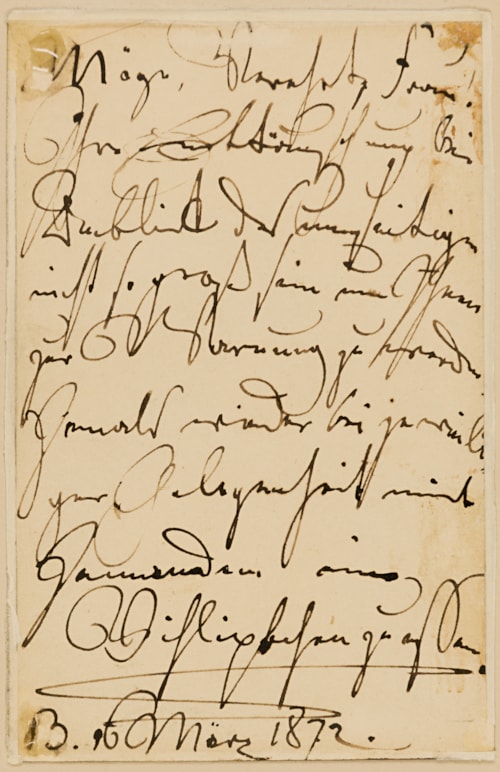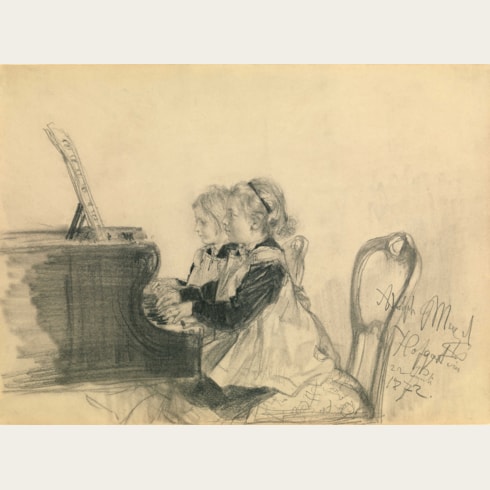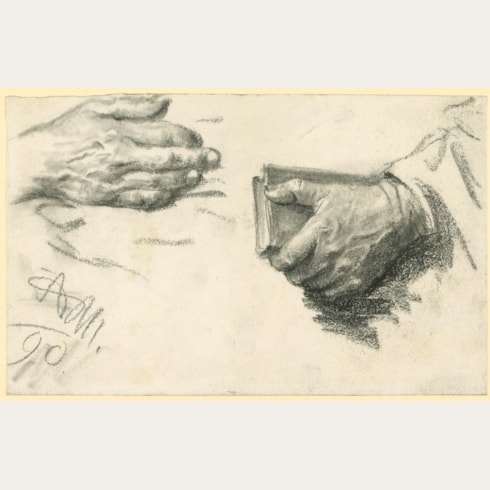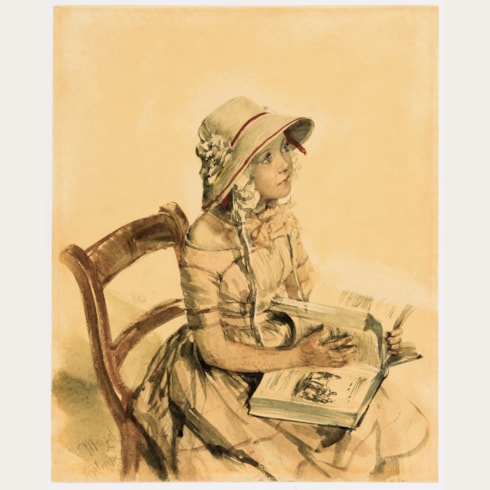Adolph MENZEL
(Breslau 1815 - Berlin 1905)
A Seated Woman Reading (Portrait of Emilie Fontane)
Extensively inscribed and dated by the artist 'Möge, Verehrte Frau, / Ihre Enttäuschung beim / Anblick des Umseitigen / nicht so groß sein, um Ihnen / zur Warnung zu Werden, / jemals wieder bei jeweili-/ ger Gelegenheit mit / Jemanden / ein Vihlipbchen [Vielliebchen] zu essen / B[erlin]16 Marz 1872.' in brown ink on the verso.
112 x 73 mm. (4 3/8 x 2 7/8 in.)
Much of Menzel’s vast corpus of drawings is executed in pencil, chalks or charcoal, and the use of watercolour is relatively rare in his drawn oeuvre. A stylistically comparable small watercolour of a young girl with a cat, of slightly smaller dimensions, is in a private collection in Germany.
Theodor Fontane frequently wrote in praise of the artist. As he once noted, ‘Menzel is the master of every branch of his art, but, even more, he is the master of his own passions. The human in him still surpasses the artist. What he is in his greatness, he is, above all, through his human qualities, through his rare incarnation of diligence, responsibility, and courage.’
The present sheet was once part of the large art collection of the industrialist Berthold Nothmann (1865-1942). A native of Upper Silesia, Nothmann worked as an employee and director of the Hudschinsky tube factories in Breslau and Gleiwitz (now Wroclau and Gliwice in Poland). A friend of Max Liebermann, Nothmann was a passionate art collector, and owned works by Paul Cézanne and Otto Mueller, among many others, and is also known to have met Henri Matisse. On his retirement in 1931, he settled first in Düsseldorf and then in Wannsee in Berlin, and devoted himself to his art collection. Much of the collection was sold, however, before Nothmann and his wife Martha emigrated to London in 1939. He died there, without descendants, in February 1942.
The present sheet has been included in a number of significant exhibitions of Menzel’s work, including the huge memorial exhibition held at the National-Galerie in Berlin in 1905 and the Ausstellung Adolph von Menzel aus Anlass seines 50 Todesjahres at the Museum Dahlem in Berlin in 1955. It was exhibited in public most recently in Berlin and London in 1965.
Adolph Friedrich Erdmann von Menzel began his career working in his father’s lithography shop in Breslau (now Wroclaw in Poland) and later in Berlin, where his family moved in 1830. A brief period of study at the Akademie der Künste in Berlin in 1833 seems to have been the sum total of his formal training, and he is thought to have taught himself how to paint. At the outset of his career he worked as an illustrator, his activity in this field perhaps best exemplified by a series of some four hundred designs for wood engravings produced to accompany Franz Kugler’s History of Frederick the Great, published in instalments between 1840 and 1842. During the late 1840’s and 1850’s he was occupied mainly with a cycle of history paintings illustrating the life of Frederick the Great.
In 1861 Menzel received his most important official commission, a painting of The Coronation of King William I at Königsberg, on which he worked for four years. In the following decade, his lifelong interest in scenes of contemporary life culminated in what is arguably his masterpiece as a painter; the large canvas of The Iron Rolling Mill, painted between 1872 and 1875 and immediately purchased by the National-Galerie in Berlin. The last three decades of his career saw Menzel firmly established as one of the leading artists in Germany, a prominent figure in Prussian society and the recipient of numerous honours including, in 1898, elevation to the nobility. In the late 1880’s he began to abandon painting in oils in favour of gouaches, although old age meant that these in turn were given up around the turn of the century. Yet he never stopped drawing in pencil and chalk, able always to find expression for his keen powers of observation. A retrospective exhibition of Menzel’s work, held at the National-Galerie in Berlin a few weeks after the artist’s death in 1905, included more than 6,400 drawings and almost 300 watercolours, together with 129 paintings and 250 prints.
A passionate and supremely gifted draughtsman, Menzel was equally adept at watercolour, pastel, gouache and chalk. He was also able to draw with either hand, although he seems to have favoured his left. An immensely prolific artist (over four thousand drawings by him, together with 77 sketchbooks, are in the collection of the Nationalgalerie in Berlin alone), it is said that Menzel was never without a sketchbook or two in his pocket. His friend Paul Meyerheim described the artist’s appearance: ‘In his overcoat he had eight pockets, which were partially filled with sketchbooks, and he could not comprehend that there are artists who make the smallest outings without having a sketchbook in their pocket…an especially large pocket was installed…to hold a leather case, which held a pad, a coupe of shading stumps and a gum eraser.’ Menzel was widely admired as a draughtsman by his contemporaries, both in Germany and abroad, and Edgar Degas, for one, is known to have owned at least one drawing by him.
Provenance
Thence by descent in the Fontane family from 1902
Berthold and Martha Nothmann, Wannsee, Berlin, by 1936
Acquired from them on 12 May 1938 by Galerie Heinemann, Munich
Purchased from them in August 1938 by Dr. Frenztel, Elbing
His sale, Berlin, Hans W. Lange, 18 October 1940, lot 529 (sold for 3,500 Reichsmarks)
Private collection, Berlin, by 1955
Herbert Klewer, Berlin, by 1965
Private collection, Berlin
Anonymous sale, Berlin, Villa Grisebach, 26 November 2014, lot 202
Private collection.
Literature
Exhibition















































